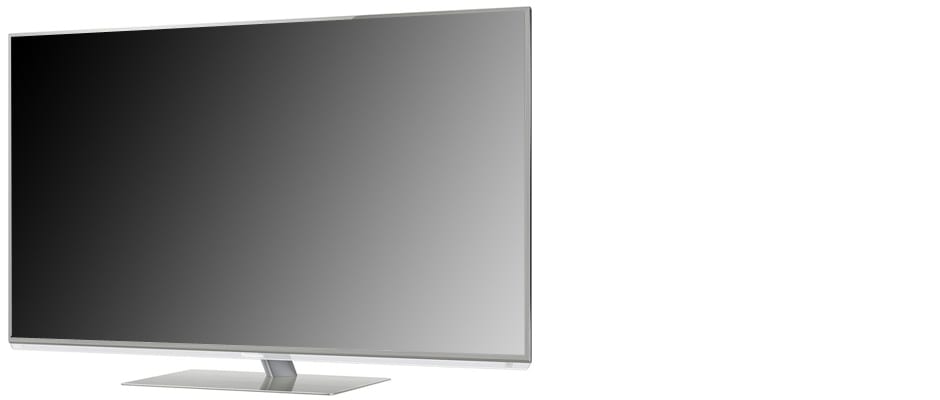Introduction
The DT50 did have its share of concerns. The color quality is average at best and the screen does not produce a good black level. Panasonic’s smart TV platform, Viera Connect, is a laborious affair, packed with slow animations and an uninspiring interface, which brings this TV down a few notches.
Design
{{section_header}}{{section.name}}{{/section_header}}
A stylish, modern vibe without seeming too futuristic.
The DT50 series is fairly normal looking with a couple additions that give it style. The thin, brushed metal bezel wrapping around the display is striking and gives the impression that the DT50 is one serious piece of hardware. Then there is the thin piece of clear plastic that bears Panasonic’s logo, which sits underneath the bezel. The Panasonic logo lights up by default, but I would recommend turning it off in the menu since it can become distracting when watching the DT50 in a dark environment.
On the back, ports are located on the right-side, with the exception of the power cord connection, which is towards the left. Side connections include an SD card slot, three USB 2.0 ports, and four HDMI ports. Located underneath this array of connections are five more: a component video input, a VGA input, a digital audio output, an antenna input, and an Ethernet jack. We have no complaints with the placement of the ports—everything was easily accessible and the 15° swivel angle that the stand provides gives enough clearance to change connections whenever necessary.
{{photo_gallery "Design Landing Page Photo", "Front Tour Image", "Back Tour Image", "Sides Tour Image", "Connectivity Tour Image 1", "Connectivity Tour Image 2", "Connectivity Extra Photo", "Stand Photo", "Controls Photo", "Remote Control Photo"}}
Smart TV Features
{{section_header}}{{section.name}}{{/section_header}}
The normal menu interface is amazing, but the smart platform is a drag.
Panasonic has done a great job designing the menu interface for the DT50. The design is simple: Each menu category is presented on the left side of the screen and labeled accordingly. Panasonic tells the user exactly what each feature does and even how to use the remote. A picture stays on the bottom of the screen that explains how to select an item and how to return to the previous screen. What really makes the menu a pleasure to use is how smooth the experience feels. There is no lag when pressing up or down on the remote to select a different category.
Panasonic took everything that was great about its menu and did the opposite for Viera Connect, its smart TV platform. Users are greeted by an uninspired and sluggish interface, made up of large, rectangular icons. Navigation is done with the arrows and the OK button, but it seems like a chore due to the laggy animation seen when selecting each item. Netflix, Hulu Plus, and Amazon Instant Video are all offered, but they seem like the only useful apps.
The browser included is not something we would recommend using, especially in the age of smartphones, tablets, and ultrabooks. Using the remote to type in a URL is simply not fun. Users must highlight each letter on the on-screen alphabetical keyboard with the arrows on the remote. Yes, Panasonic is using an alphabetical keyboard and not the intuitive QWERTY variety. What's worse is that webpages are slow to load. Do not use this browser.
{{photo_gallery "Software and Internet Landing Page Photo", "Internet Features 1 Photo", "Internet Features 2 Photo", "Internet Features 3 Photo", "Browser 1 Photo", "Browser 2 Photo", "Browser 3 Photo", "Apps 1 Photo", "Apps 2 Photo", "Apps 3 Photo", "Local Media Playback 1 Photo", "Local Media Playback 2 Photo", "Menu Main Photo", "Menu 2 Photo"}}
Picture Quality
{{section_header}}{{section.name}}{{/section_header}}
Average colors and contrast, but the viewing angle is killer.
The Panasonic DT50 ran into some trouble with color accuracy and consistency. The actual colors do not match up with the mythical "industry standard," which is another way of saying the colors will look off. On top of this, the contrast was average, but not special. The screen on the DT50 is bright; while the white levels this Panasonic can produce are great, the black levels are disappointing.
During our motion tests, the DT50 had some obvious motion artifacting. There was noticeable blur on images, often referred to as jerkiness, and jagged lines were also present on edges and straight lines. There did not seem to be any color trailing—which looks just as bad as it sounds—when images moved across the screen.
The viewing angle deserves to be mentioned because of how incredible it is. The DT50 produced a total viewing angle of 120°, which is better than many plasma TVs. Not bad, Panasonic.
3D
{{section_header}}{{section.name}}{{/section_header}}
Good quality 3D with uncomfortable (and expensive) glasses.
Panasonic uses active shutter technology for all of their current 3D TVs. This method of creating 3D involves the TV producing alternating frames, which are then synced up to the active shutter glasses. The result is a full 1080p image shown to each eye. When these images are alternating at a high enough frequency, the brain perceives 3D.
Does this fancy technology produce a good 3D experience on the DT50? It sure does. The 3D effect was clearly noticeable but never overwhelming. Objects in the foreground would typically “pop out” of the screen. Impressive stuff, indeed. The only drawback to this experience is that Panasonic does not include the aforementioned 3D glasses, which cost around $50 each. To make matters worse, these are not the most comfortable glasses to wear due to their bulky nature.
Conclusion
{{section_header}}{{section.name}}{{/section_header}}
Disappointing performance results make this a tough recommendation.
The two best features on the Panasonic DT50, aside from the design, are the exceptional viewing angle and good quality 3D. Unfortunately, the picture quality suffered from inaccurate colors and motion performance that wasn't the best.
Viera Connect, Panasonic’s smart TV platform, is another detriment. It’s a mediocre improvement over last year’s version, integrating a frustrating browser experience and sluggish interface. Panasonic has a long way to go if it wants to catch up with LG and Samsung in this category.
With an MSRP of $1,899, the Panasonic TC-L47DT50 is a pretty expensive TV for the performance it offers. If you are looking for a TV that only offers a great mix of 3D and a screen that everyone in the living room can view, this Panasonic is worth checking out. Otherwise, keep your options open.
Science Introduction
{{section_header}}{{section.name}}{{/section_header}}
The viewing angle was fantastic on the Panasonic DT50. Unfortunately, many of its other features, like color and contrast, were not impressive in the least.
Viewing Angle
{{section_header}}{{section.name}}{{/section_header}}
An incredibly wide viewing angle for an LCD.
LCD TVs typically do not have the best viewing angles, at least compared to their plasma cousins. The Panasonic TC-L47DT50 bucks this trend and left the competition in the dust with an astonishing 120° total viewing angle. More on how we test viewing angle.
{{photo_gallery "Science Section 1 Images"}}
Color
{{section_header}}{{section.name}}{{/section_header}}
Everything looks slightly off.
According to our color gamut chart, the greens are slightly undersaturated and the blues are very undersaturated, meaning that these colors will appear less vibrant than they should. Reds, on the other hand, are slightly more vivid than they should be. More on how we test color performance.
{{photo_gallery "Science Section 2 Images"}}
Contrast
{{section_header}}{{section.name}}{{/section_header}}
The DT50 produces a laughable black level.
A contrast ratio of 1304:1 is not bad by any means, but the black level of 0.27 cd/m2 is pretty bad. This means that darker colors and darker greys will have a lack of definition. More on how we test contrast.
{{photo_gallery "Science Section 3 Images"}}
Other Tests
{{section_header}}{{section.name}}{{/section_header}}
{{photo_gallery "Other Tests Images"}}
Meet the tester
An enthusiast of all things tech, Josh is one of Reviewed.com's resident television experts. When he's not looking at bright TV screens in a dark room, he's probably reviewing a laptop or finding a new snack at 7-11.
Checking our work.
Our team is here for one purpose: to help you buy the best stuff and love what you own. Our writers, editors, and lab technicians obsess over the products we cover to make sure you're confident and satisfied. Have a different opinion about something we recommend? Email us and we'll compare notes.
Shoot us an email


